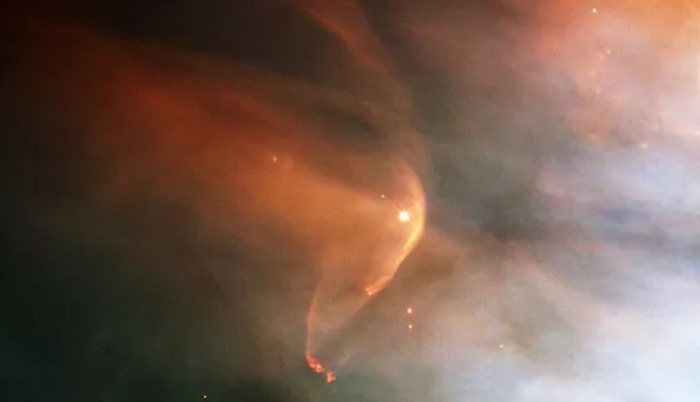![]() Home > Space & Science
Home > Space & Science
These 3 Stars Are Losing Weight Fast — Thanks To Stellar Winds Way Stronger Than The Sun's

Shockwave created by the massive star Zeta Ophiuchi in an interstellar dust cloud. (Image credit: NASA/JPL-Caltech; NASA and The Hubble Heritage Team (STScI/AURA); C. R. O'Dell, Vanderbilt University)
![]() April 16th, 2024 | 11:41 AM |
April 16th, 2024 | 11:41 AM | ![]() 472 views
472 views
SPACE
"Our estimated mass-loss rates can be used as a benchmark for stellar wind models and expand our limited observational evidence for the winds of sun-like stars."
Astronomers have, for the first time, detected stellar winds blowing from three main-sequence stars similar to the sun.
The observation helped determine the rates at which these stars lose mass via their stellar winds, finding these winds shrink about 67 times as fast as the sun loses mass via its own solar winds.
The team behind the research reached these findings by observing X-rays emitted by a hot plasma bubble called the "astrosphere" that surrounds star systems. This plasma gets inflated by stellar winds slamming into the interstellar medium, which refers to gas and dust that exists between stars. Astrospheres are analogous to the heliosphere that surrounds the solar system.
Stellar winds can also trigger processes that evaporate the atmospheres of planets that orbit the stars from which the winds flow, reducing the capacity for those worlds to host life (as we know it, at least.)
The escape rate of planetary atmospheres is slow, but these losses can accumulate, transforming an Earth-like world to a barren, atmosphere-less space rock over the course of millions of years. This means these new observations can help scientists understand how planets evolve around sun-like stars, and could aid in identifying which planetary systems are more likely to have habitable planets.
Despite the importance of stellar winds to a planetary system's evolution, the winds of sun-like, main-sequence stars have been very difficult to measure.
"In the solar system, solar wind charge exchange emission has been observed from planets, comets and the heliosphere, and provides a natural laboratory to study the solar wind's composition," research leader and University of Vienna astrophysicist Kristina Kislyakova said in a statement. "Observing this emission from distant stars is much more tricky due to the faintness of the signal."
Kislyakova added that the distance to these stars makes it very difficult to disentangle X-ray signals emitted by the astrosphere from X-ray emissions of the star itself, which appears "spread" over the observing telescope's field-of-view.
After making observations of these star systems with the XMM-Newton space telescope, however, the team developed a new algorithm to disentangle stellar and astrospheric contributions to X-ray emissions.
This allowed the researchers to detect the exchange of charge between oxygen ions in the stellar winds and neutral atoms in the interstellar medium of three main-sequence stars: 70 Ophiuchi located some 16.6 light years away, epsilon Eridani which lies about 10.5 light-years away, and 61 Cygni, a binary star system approximately 11.4 light-years from Earth.
"This has been the first time X-ray charge exchange emission from astrospheres of such stars has been detected," Kislyakova said. "Our estimated mass-loss rates can be used as a benchmark for stellar wind models and expand our limited observational evidence for the winds of sun-like stars."
The team determined that 70 Ophiuchi was losing mass at a rate around 67 times that of the sun, and epsilon Eridani was losing mass around 16 times as fast as the sun. 61 Cygni was losing mass the slowest, albeit at a rate that is still 10 times faster than that of our star. Thus, the stellar winds of these stars that blast their planets and inflate their astrospheres are much more powerful than solar winds flowing from the sun. This may be because these stars have much stronger magnetic activity than our host star.
"There have been worldwide efforts over three decades to substantiate the presence of winds around sun-like stars and measure their strengths, but so far only indirect evidence based on their secondary effects on the star or its environment alluded to the existence of such winds," Manuel Güdel, team member and a University of Vienna researcher, said in the statement. "Our group previously tried to detect radio emission from the winds but could only place upper limits to the wind strengths while not detecting the winds themselves.
"Our new X-ray-based results pave the way to finding and even imaging these winds directly and studying their interactions with surrounding planets."
The team's research was published on Friday (April 12) in the journal Nature Astronomy.
Source:
courtesy of SPACE
by Robert Lea
If you have any stories or news that you would like to share with the global online community, please feel free to share it with us by contacting us directly at [email protected]